Developmental Theories in Early Childhood
VerifiedAdded on 2022/12/23
|14
|4085
|1
AI Summary
This paper explores the developmental theories in early childhood and their impact on child development. It discusses Erikson's Psychosocial Developmental Theory, Bowlby's Attachment Theory, Bandura's Social Learning Theory, and Piaget's Cognitive Developmental Theory. The observation of a 2-year-old child's physical, communication, and psychosocial development is examined, along with therapeutic communication skills and recommendations for improving childhood development.
Contribute Materials
Your contribution can guide someone’s learning journey. Share your
documents today.
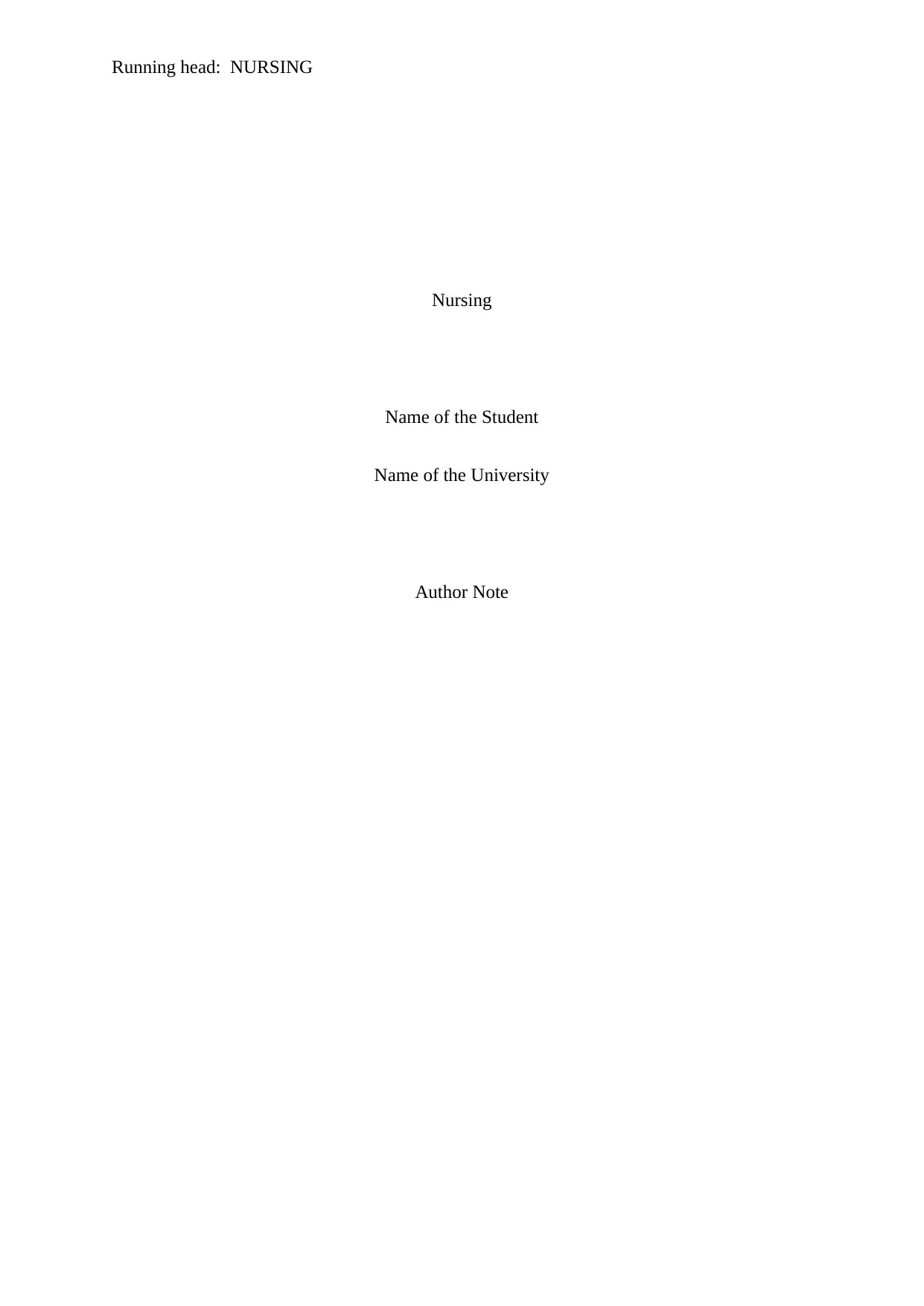
Running head: NURSING
Nursing
Name of the Student
Name of the University
Author Note
Nursing
Name of the Student
Name of the University
Author Note
Secure Best Marks with AI Grader
Need help grading? Try our AI Grader for instant feedback on your assignments.
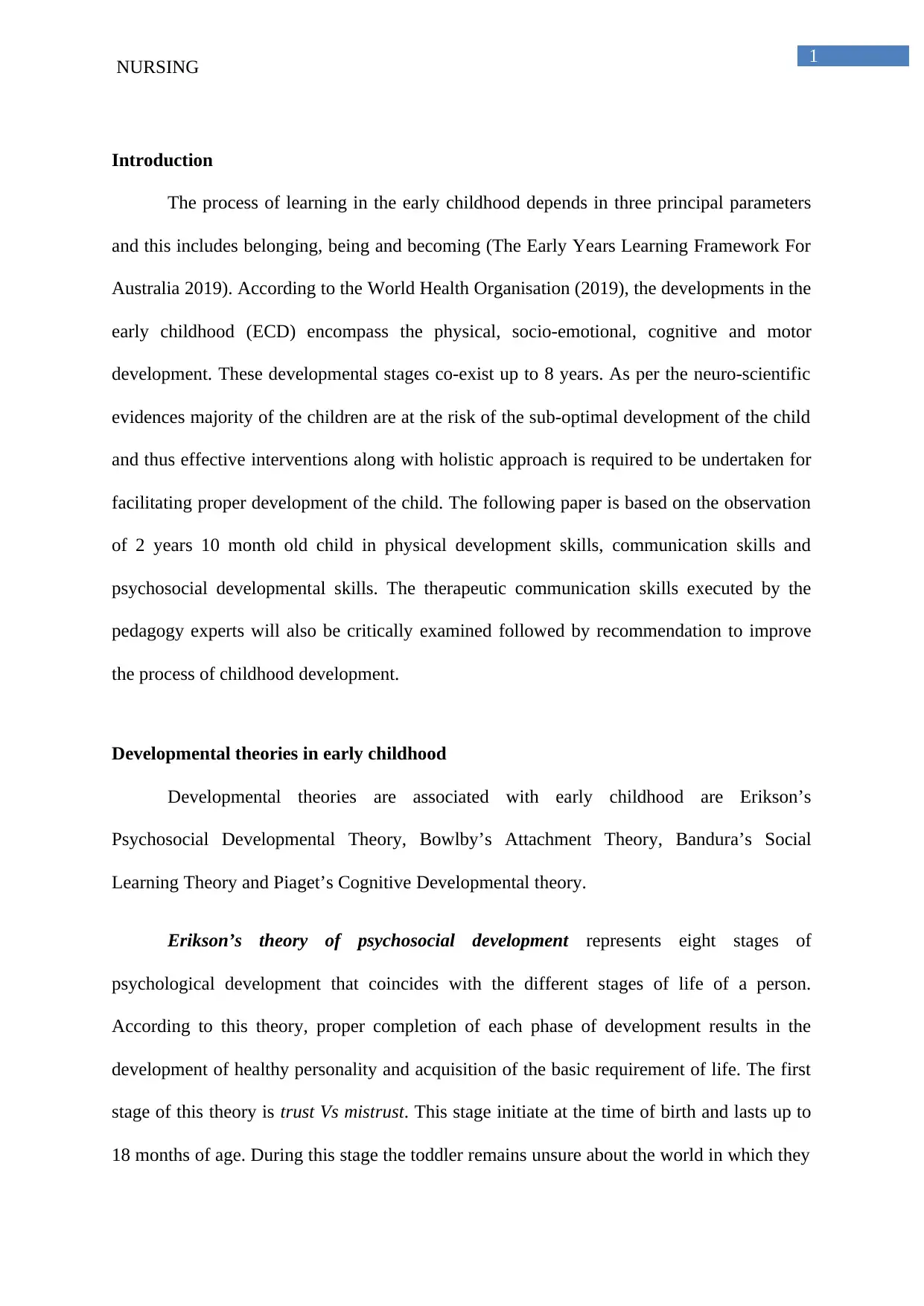
1
NURSING
Introduction
The process of learning in the early childhood depends in three principal parameters
and this includes belonging, being and becoming (The Early Years Learning Framework For
Australia 2019). According to the World Health Organisation (2019), the developments in the
early childhood (ECD) encompass the physical, socio-emotional, cognitive and motor
development. These developmental stages co-exist up to 8 years. As per the neuro-scientific
evidences majority of the children are at the risk of the sub-optimal development of the child
and thus effective interventions along with holistic approach is required to be undertaken for
facilitating proper development of the child. The following paper is based on the observation
of 2 years 10 month old child in physical development skills, communication skills and
psychosocial developmental skills. The therapeutic communication skills executed by the
pedagogy experts will also be critically examined followed by recommendation to improve
the process of childhood development.
Developmental theories in early childhood
Developmental theories are associated with early childhood are Erikson’s
Psychosocial Developmental Theory, Bowlby’s Attachment Theory, Bandura’s Social
Learning Theory and Piaget’s Cognitive Developmental theory.
Erikson’s theory of psychosocial development represents eight stages of
psychological development that coincides with the different stages of life of a person.
According to this theory, proper completion of each phase of development results in the
development of healthy personality and acquisition of the basic requirement of life. The first
stage of this theory is trust Vs mistrust. This stage initiate at the time of birth and lasts up to
18 months of age. During this stage the toddler remains unsure about the world in which they
NURSING
Introduction
The process of learning in the early childhood depends in three principal parameters
and this includes belonging, being and becoming (The Early Years Learning Framework For
Australia 2019). According to the World Health Organisation (2019), the developments in the
early childhood (ECD) encompass the physical, socio-emotional, cognitive and motor
development. These developmental stages co-exist up to 8 years. As per the neuro-scientific
evidences majority of the children are at the risk of the sub-optimal development of the child
and thus effective interventions along with holistic approach is required to be undertaken for
facilitating proper development of the child. The following paper is based on the observation
of 2 years 10 month old child in physical development skills, communication skills and
psychosocial developmental skills. The therapeutic communication skills executed by the
pedagogy experts will also be critically examined followed by recommendation to improve
the process of childhood development.
Developmental theories in early childhood
Developmental theories are associated with early childhood are Erikson’s
Psychosocial Developmental Theory, Bowlby’s Attachment Theory, Bandura’s Social
Learning Theory and Piaget’s Cognitive Developmental theory.
Erikson’s theory of psychosocial development represents eight stages of
psychological development that coincides with the different stages of life of a person.
According to this theory, proper completion of each phase of development results in the
development of healthy personality and acquisition of the basic requirement of life. The first
stage of this theory is trust Vs mistrust. This stage initiate at the time of birth and lasts up to
18 months of age. During this stage the toddler remains unsure about the world in which they

2
NURSING
resides and mainly look up to the primary care givers for stability and consistency in care
(Villar and Pratt 2015). In relation to the case study it can be said that girl child observed in
the Kindergym during the session of gymsports was 2 years and 10 month old. However,
during the entire day in the gym sport it is significantly evident that she has a trust issues with
the unknown persons and is only comfortable in communicating and playing with her mother
who is her primary care giver. Due to her trust issues, she has only one friend in the kinder
gym. Knight (2017) are of the opinion that if the care of the infant is consistent and is
predictable or reliable, the child develops a feeling of trust trust which help them to carry
other relationships and they are able to feel secure even when they are threatened. The girl
child analysed in the case study, refuse the feel secure in the absence of her mother as she
always made sure that her mother is sitting closer to her when the event of singing was
happening in the story time sessions. She was also shy to the strangers but was interacting
comfortably with her mother. Thus it can be extracted from the case study that there is a
delay in the psychological development for this concerned girl child. The second stage of the
Erickson psychosocial development is autonomy vs shame and doubt. This stage occurs from
18 months of age and last for up to 3 years. During this phase, the children are focused on
developing personal control in the domain of physical skills along with the development of a
sense of independence. Zhang (2015) are of the opinion that success at this stage depends that
encourage and support given to the child in order to increase their level of independence and
become self-confident and secured about their own ability in-front of the world. However, as
per the observation of the girl child in the kinder gym it can be said that she lacks the
required confidence. Like during the story time, when few of the kids started doing some
actions while singing, she preferred to sit down with her mom and refused to come forward.
She also rarely plays with other kids. In order words it can be said that she lacks the required
confidence in order to take active initiatives to interact with the world. But when it comes of
NURSING
resides and mainly look up to the primary care givers for stability and consistency in care
(Villar and Pratt 2015). In relation to the case study it can be said that girl child observed in
the Kindergym during the session of gymsports was 2 years and 10 month old. However,
during the entire day in the gym sport it is significantly evident that she has a trust issues with
the unknown persons and is only comfortable in communicating and playing with her mother
who is her primary care giver. Due to her trust issues, she has only one friend in the kinder
gym. Knight (2017) are of the opinion that if the care of the infant is consistent and is
predictable or reliable, the child develops a feeling of trust trust which help them to carry
other relationships and they are able to feel secure even when they are threatened. The girl
child analysed in the case study, refuse the feel secure in the absence of her mother as she
always made sure that her mother is sitting closer to her when the event of singing was
happening in the story time sessions. She was also shy to the strangers but was interacting
comfortably with her mother. Thus it can be extracted from the case study that there is a
delay in the psychological development for this concerned girl child. The second stage of the
Erickson psychosocial development is autonomy vs shame and doubt. This stage occurs from
18 months of age and last for up to 3 years. During this phase, the children are focused on
developing personal control in the domain of physical skills along with the development of a
sense of independence. Zhang (2015) are of the opinion that success at this stage depends that
encourage and support given to the child in order to increase their level of independence and
become self-confident and secured about their own ability in-front of the world. However, as
per the observation of the girl child in the kinder gym it can be said that she lacks the
required confidence. Like during the story time, when few of the kids started doing some
actions while singing, she preferred to sit down with her mom and refused to come forward.
She also rarely plays with other kids. In order words it can be said that she lacks the required
confidence in order to take active initiatives to interact with the world. But when it comes of
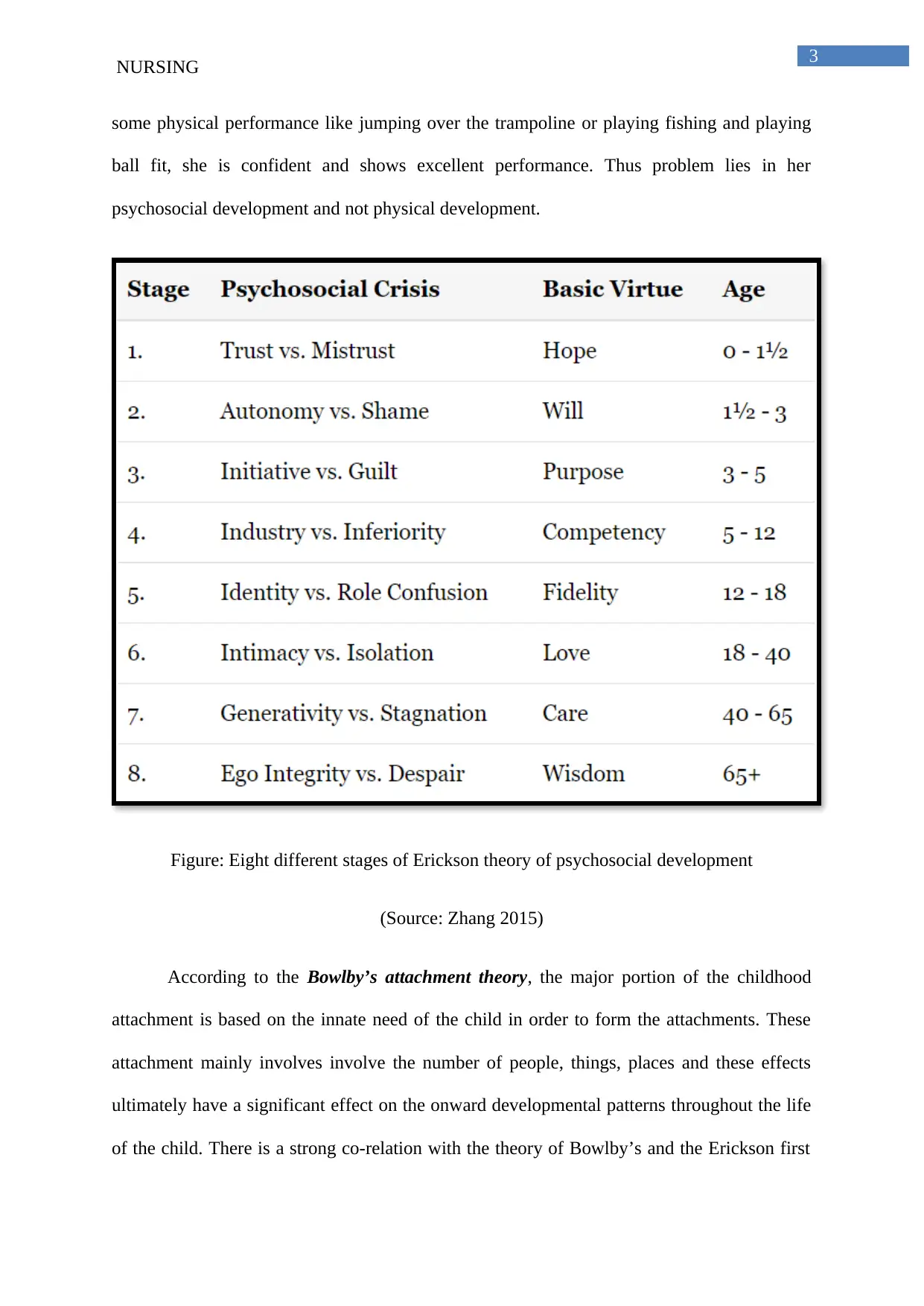
3
NURSING
some physical performance like jumping over the trampoline or playing fishing and playing
ball fit, she is confident and shows excellent performance. Thus problem lies in her
psychosocial development and not physical development.
Figure: Eight different stages of Erickson theory of psychosocial development
(Source: Zhang 2015)
According to the Bowlby’s attachment theory, the major portion of the childhood
attachment is based on the innate need of the child in order to form the attachments. These
attachment mainly involves involve the number of people, things, places and these effects
ultimately have a significant effect on the onward developmental patterns throughout the life
of the child. There is a strong co-relation with the theory of Bowlby’s and the Erickson first
NURSING
some physical performance like jumping over the trampoline or playing fishing and playing
ball fit, she is confident and shows excellent performance. Thus problem lies in her
psychosocial development and not physical development.
Figure: Eight different stages of Erickson theory of psychosocial development
(Source: Zhang 2015)
According to the Bowlby’s attachment theory, the major portion of the childhood
attachment is based on the innate need of the child in order to form the attachments. These
attachment mainly involves involve the number of people, things, places and these effects
ultimately have a significant effect on the onward developmental patterns throughout the life
of the child. There is a strong co-relation with the theory of Bowlby’s and the Erickson first
Secure Best Marks with AI Grader
Need help grading? Try our AI Grader for instant feedback on your assignments.
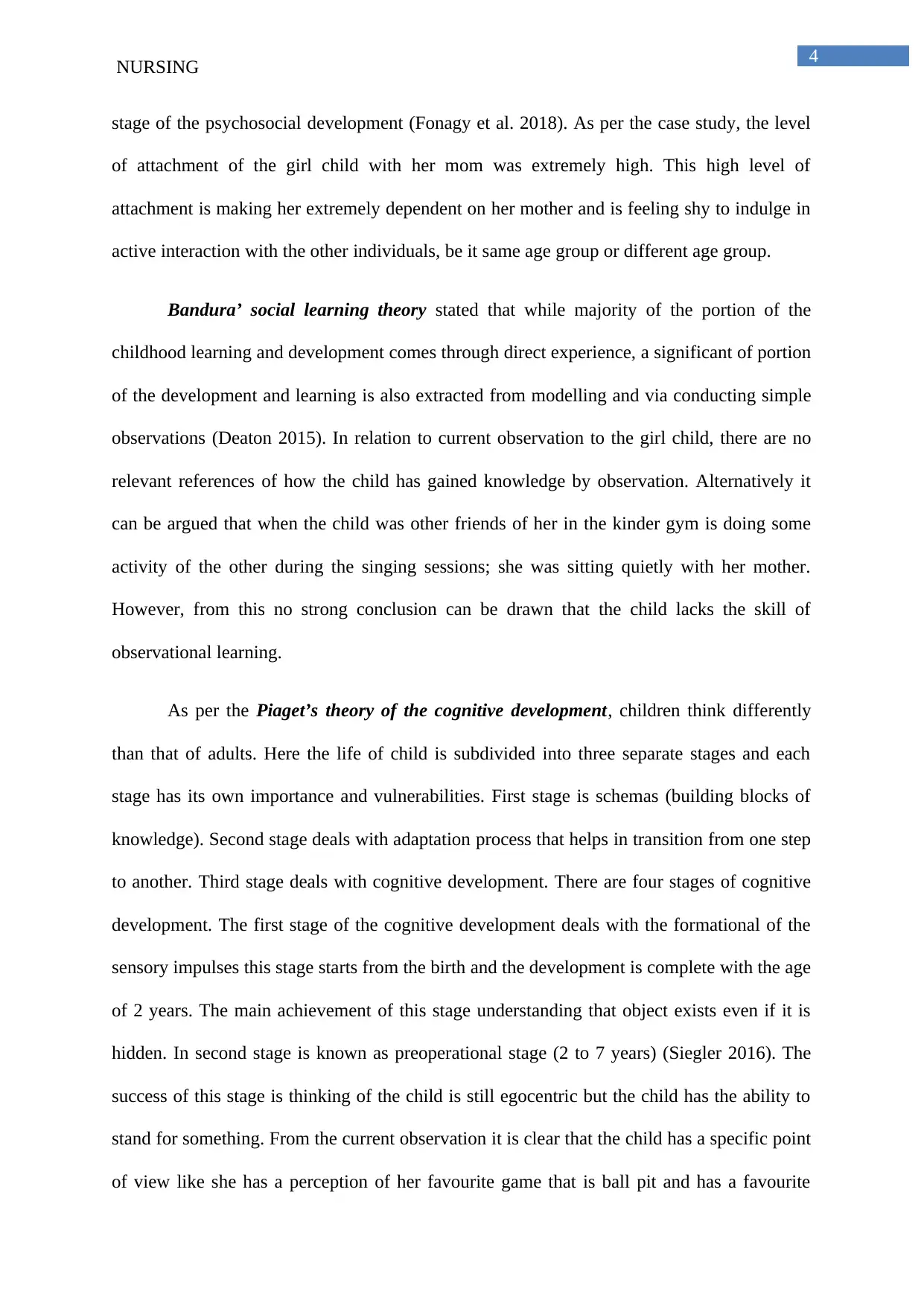
4
NURSING
stage of the psychosocial development (Fonagy et al. 2018). As per the case study, the level
of attachment of the girl child with her mom was extremely high. This high level of
attachment is making her extremely dependent on her mother and is feeling shy to indulge in
active interaction with the other individuals, be it same age group or different age group.
Bandura’ social learning theory stated that while majority of the portion of the
childhood learning and development comes through direct experience, a significant of portion
of the development and learning is also extracted from modelling and via conducting simple
observations (Deaton 2015). In relation to current observation to the girl child, there are no
relevant references of how the child has gained knowledge by observation. Alternatively it
can be argued that when the child was other friends of her in the kinder gym is doing some
activity of the other during the singing sessions; she was sitting quietly with her mother.
However, from this no strong conclusion can be drawn that the child lacks the skill of
observational learning.
As per the Piaget’s theory of the cognitive development, children think differently
than that of adults. Here the life of child is subdivided into three separate stages and each
stage has its own importance and vulnerabilities. First stage is schemas (building blocks of
knowledge). Second stage deals with adaptation process that helps in transition from one step
to another. Third stage deals with cognitive development. There are four stages of cognitive
development. The first stage of the cognitive development deals with the formational of the
sensory impulses this stage starts from the birth and the development is complete with the age
of 2 years. The main achievement of this stage understanding that object exists even if it is
hidden. In second stage is known as preoperational stage (2 to 7 years) (Siegler 2016). The
success of this stage is thinking of the child is still egocentric but the child has the ability to
stand for something. From the current observation it is clear that the child has a specific point
of view like she has a perception of her favourite game that is ball pit and has a favourite
NURSING
stage of the psychosocial development (Fonagy et al. 2018). As per the case study, the level
of attachment of the girl child with her mom was extremely high. This high level of
attachment is making her extremely dependent on her mother and is feeling shy to indulge in
active interaction with the other individuals, be it same age group or different age group.
Bandura’ social learning theory stated that while majority of the portion of the
childhood learning and development comes through direct experience, a significant of portion
of the development and learning is also extracted from modelling and via conducting simple
observations (Deaton 2015). In relation to current observation to the girl child, there are no
relevant references of how the child has gained knowledge by observation. Alternatively it
can be argued that when the child was other friends of her in the kinder gym is doing some
activity of the other during the singing sessions; she was sitting quietly with her mother.
However, from this no strong conclusion can be drawn that the child lacks the skill of
observational learning.
As per the Piaget’s theory of the cognitive development, children think differently
than that of adults. Here the life of child is subdivided into three separate stages and each
stage has its own importance and vulnerabilities. First stage is schemas (building blocks of
knowledge). Second stage deals with adaptation process that helps in transition from one step
to another. Third stage deals with cognitive development. There are four stages of cognitive
development. The first stage of the cognitive development deals with the formational of the
sensory impulses this stage starts from the birth and the development is complete with the age
of 2 years. The main achievement of this stage understanding that object exists even if it is
hidden. In second stage is known as preoperational stage (2 to 7 years) (Siegler 2016). The
success of this stage is thinking of the child is still egocentric but the child has the ability to
stand for something. From the current observation it is clear that the child has a specific point
of view like she has a perception of her favourite game that is ball pit and has a favourite
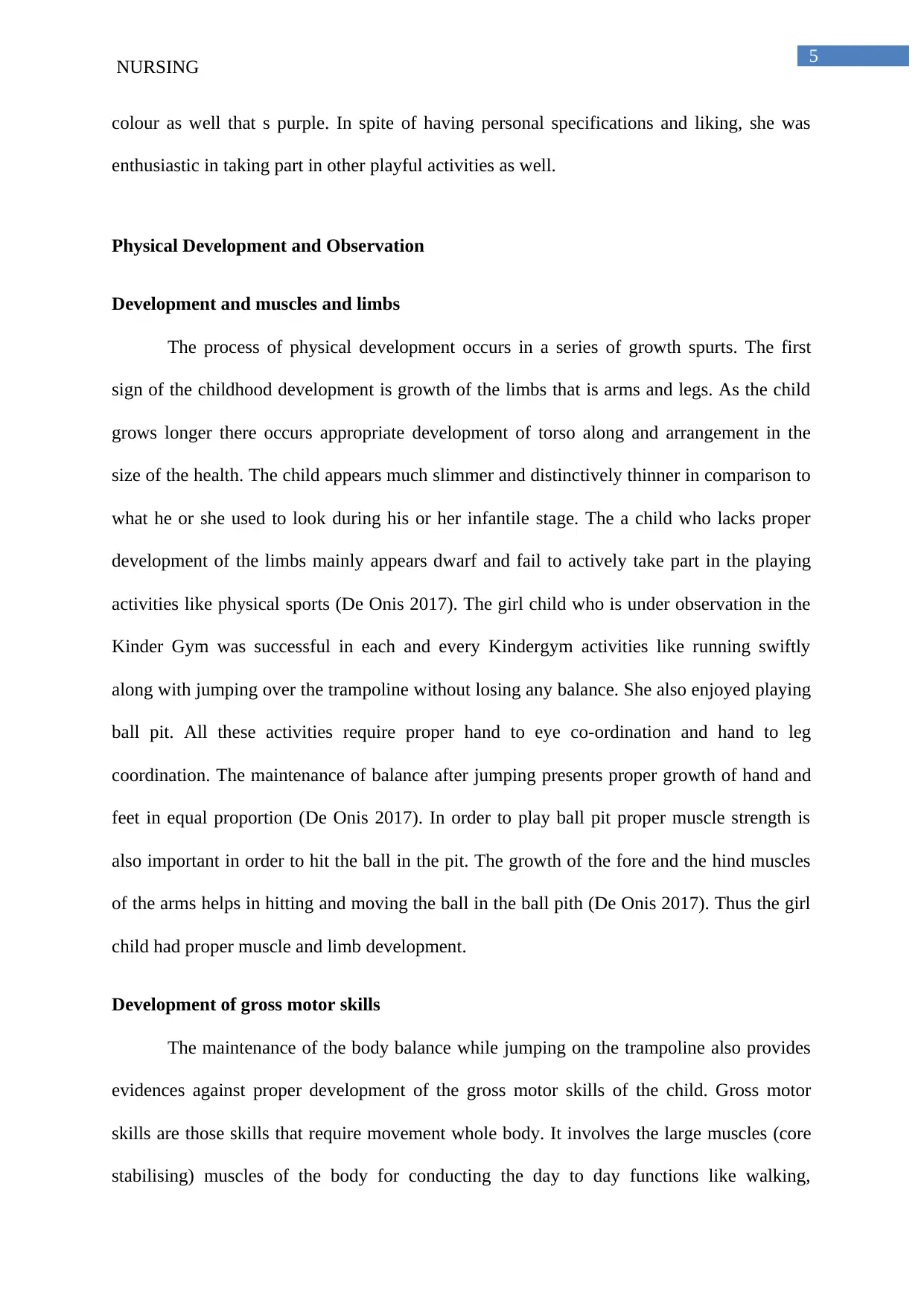
5
NURSING
colour as well that s purple. In spite of having personal specifications and liking, she was
enthusiastic in taking part in other playful activities as well.
Physical Development and Observation
Development and muscles and limbs
The process of physical development occurs in a series of growth spurts. The first
sign of the childhood development is growth of the limbs that is arms and legs. As the child
grows longer there occurs appropriate development of torso along and arrangement in the
size of the health. The child appears much slimmer and distinctively thinner in comparison to
what he or she used to look during his or her infantile stage. The a child who lacks proper
development of the limbs mainly appears dwarf and fail to actively take part in the playing
activities like physical sports (De Onis 2017). The girl child who is under observation in the
Kinder Gym was successful in each and every Kindergym activities like running swiftly
along with jumping over the trampoline without losing any balance. She also enjoyed playing
ball pit. All these activities require proper hand to eye co-ordination and hand to leg
coordination. The maintenance of balance after jumping presents proper growth of hand and
feet in equal proportion (De Onis 2017). In order to play ball pit proper muscle strength is
also important in order to hit the ball in the pit. The growth of the fore and the hind muscles
of the arms helps in hitting and moving the ball in the ball pith (De Onis 2017). Thus the girl
child had proper muscle and limb development.
Development of gross motor skills
The maintenance of the body balance while jumping on the trampoline also provides
evidences against proper development of the gross motor skills of the child. Gross motor
skills are those skills that require movement whole body. It involves the large muscles (core
stabilising) muscles of the body for conducting the day to day functions like walking,
NURSING
colour as well that s purple. In spite of having personal specifications and liking, she was
enthusiastic in taking part in other playful activities as well.
Physical Development and Observation
Development and muscles and limbs
The process of physical development occurs in a series of growth spurts. The first
sign of the childhood development is growth of the limbs that is arms and legs. As the child
grows longer there occurs appropriate development of torso along and arrangement in the
size of the health. The child appears much slimmer and distinctively thinner in comparison to
what he or she used to look during his or her infantile stage. The a child who lacks proper
development of the limbs mainly appears dwarf and fail to actively take part in the playing
activities like physical sports (De Onis 2017). The girl child who is under observation in the
Kinder Gym was successful in each and every Kindergym activities like running swiftly
along with jumping over the trampoline without losing any balance. She also enjoyed playing
ball pit. All these activities require proper hand to eye co-ordination and hand to leg
coordination. The maintenance of balance after jumping presents proper growth of hand and
feet in equal proportion (De Onis 2017). In order to play ball pit proper muscle strength is
also important in order to hit the ball in the pit. The growth of the fore and the hind muscles
of the arms helps in hitting and moving the ball in the ball pith (De Onis 2017). Thus the girl
child had proper muscle and limb development.
Development of gross motor skills
The maintenance of the body balance while jumping on the trampoline also provides
evidences against proper development of the gross motor skills of the child. Gross motor
skills are those skills that require movement whole body. It involves the large muscles (core
stabilising) muscles of the body for conducting the day to day functions like walking,
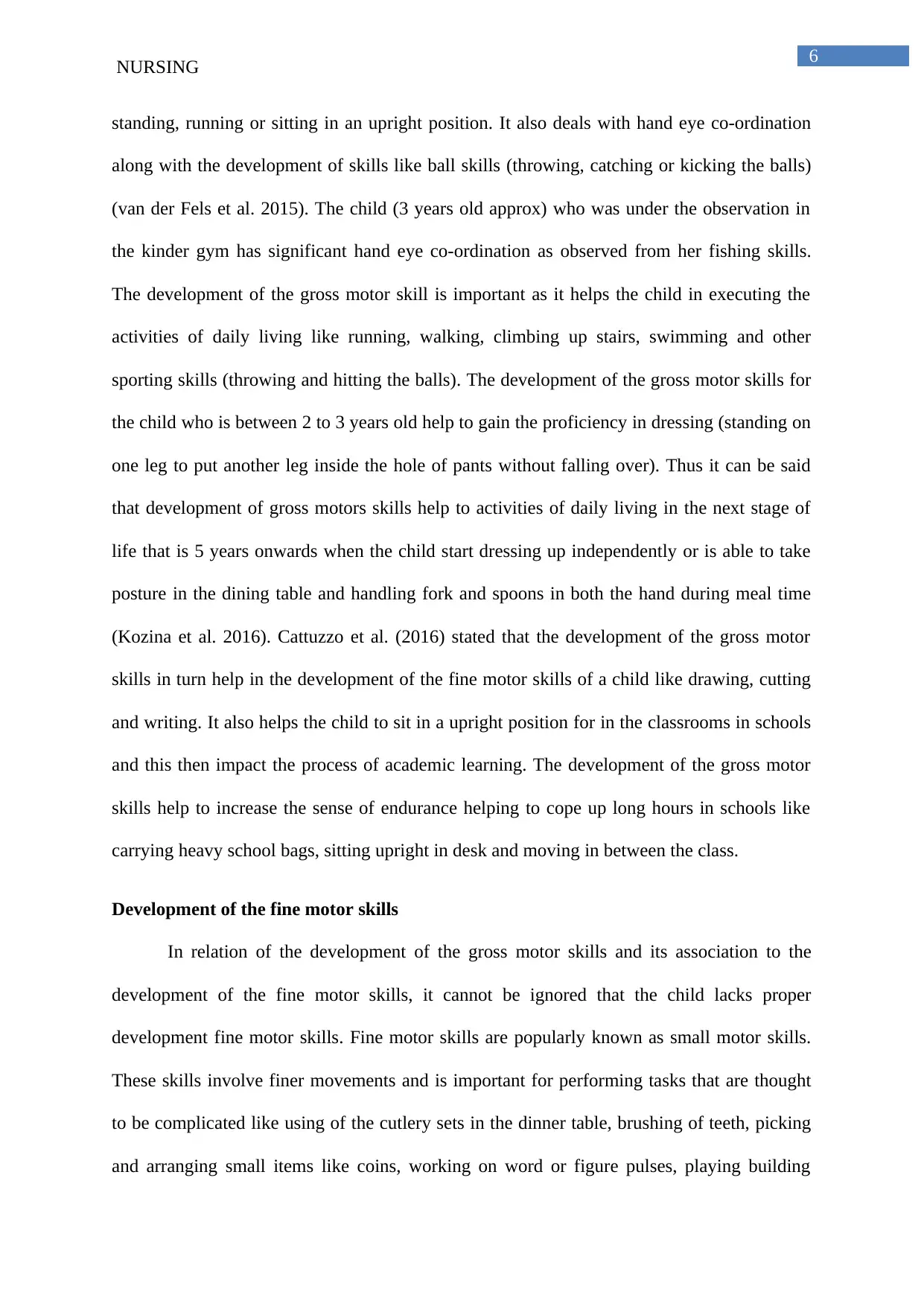
6
NURSING
standing, running or sitting in an upright position. It also deals with hand eye co-ordination
along with the development of skills like ball skills (throwing, catching or kicking the balls)
(van der Fels et al. 2015). The child (3 years old approx) who was under the observation in
the kinder gym has significant hand eye co-ordination as observed from her fishing skills.
The development of the gross motor skill is important as it helps the child in executing the
activities of daily living like running, walking, climbing up stairs, swimming and other
sporting skills (throwing and hitting the balls). The development of the gross motor skills for
the child who is between 2 to 3 years old help to gain the proficiency in dressing (standing on
one leg to put another leg inside the hole of pants without falling over). Thus it can be said
that development of gross motors skills help to activities of daily living in the next stage of
life that is 5 years onwards when the child start dressing up independently or is able to take
posture in the dining table and handling fork and spoons in both the hand during meal time
(Kozina et al. 2016). Cattuzzo et al. (2016) stated that the development of the gross motor
skills in turn help in the development of the fine motor skills of a child like drawing, cutting
and writing. It also helps the child to sit in a upright position for in the classrooms in schools
and this then impact the process of academic learning. The development of the gross motor
skills help to increase the sense of endurance helping to cope up long hours in schools like
carrying heavy school bags, sitting upright in desk and moving in between the class.
Development of the fine motor skills
In relation of the development of the gross motor skills and its association to the
development of the fine motor skills, it cannot be ignored that the child lacks proper
development fine motor skills. Fine motor skills are popularly known as small motor skills.
These skills involve finer movements and is important for performing tasks that are thought
to be complicated like using of the cutlery sets in the dinner table, brushing of teeth, picking
and arranging small items like coins, working on word or figure pulses, playing building
NURSING
standing, running or sitting in an upright position. It also deals with hand eye co-ordination
along with the development of skills like ball skills (throwing, catching or kicking the balls)
(van der Fels et al. 2015). The child (3 years old approx) who was under the observation in
the kinder gym has significant hand eye co-ordination as observed from her fishing skills.
The development of the gross motor skill is important as it helps the child in executing the
activities of daily living like running, walking, climbing up stairs, swimming and other
sporting skills (throwing and hitting the balls). The development of the gross motor skills for
the child who is between 2 to 3 years old help to gain the proficiency in dressing (standing on
one leg to put another leg inside the hole of pants without falling over). Thus it can be said
that development of gross motors skills help to activities of daily living in the next stage of
life that is 5 years onwards when the child start dressing up independently or is able to take
posture in the dining table and handling fork and spoons in both the hand during meal time
(Kozina et al. 2016). Cattuzzo et al. (2016) stated that the development of the gross motor
skills in turn help in the development of the fine motor skills of a child like drawing, cutting
and writing. It also helps the child to sit in a upright position for in the classrooms in schools
and this then impact the process of academic learning. The development of the gross motor
skills help to increase the sense of endurance helping to cope up long hours in schools like
carrying heavy school bags, sitting upright in desk and moving in between the class.
Development of the fine motor skills
In relation of the development of the gross motor skills and its association to the
development of the fine motor skills, it cannot be ignored that the child lacks proper
development fine motor skills. Fine motor skills are popularly known as small motor skills.
These skills involve finer movements and is important for performing tasks that are thought
to be complicated like using of the cutlery sets in the dinner table, brushing of teeth, picking
and arranging small items like coins, working on word or figure pulses, playing building
Paraphrase This Document
Need a fresh take? Get an instant paraphrase of this document with our AI Paraphraser
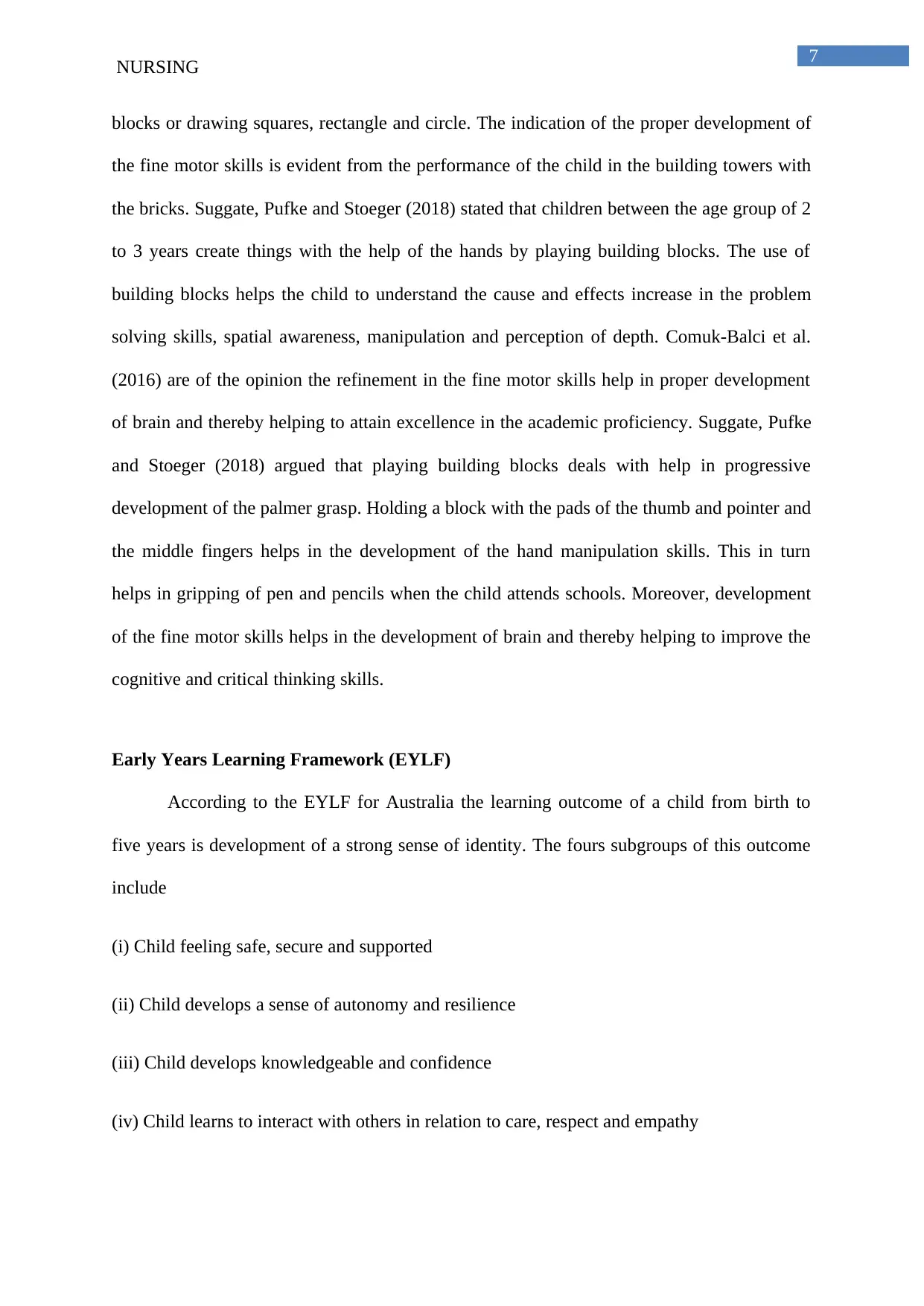
7
NURSING
blocks or drawing squares, rectangle and circle. The indication of the proper development of
the fine motor skills is evident from the performance of the child in the building towers with
the bricks. Suggate, Pufke and Stoeger (2018) stated that children between the age group of 2
to 3 years create things with the help of the hands by playing building blocks. The use of
building blocks helps the child to understand the cause and effects increase in the problem
solving skills, spatial awareness, manipulation and perception of depth. Comuk-Balci et al.
(2016) are of the opinion the refinement in the fine motor skills help in proper development
of brain and thereby helping to attain excellence in the academic proficiency. Suggate, Pufke
and Stoeger (2018) argued that playing building blocks deals with help in progressive
development of the palmer grasp. Holding a block with the pads of the thumb and pointer and
the middle fingers helps in the development of the hand manipulation skills. This in turn
helps in gripping of pen and pencils when the child attends schools. Moreover, development
of the fine motor skills helps in the development of brain and thereby helping to improve the
cognitive and critical thinking skills.
Early Years Learning Framework (EYLF)
According to the EYLF for Australia the learning outcome of a child from birth to
five years is development of a strong sense of identity. The fours subgroups of this outcome
include
(i) Child feeling safe, secure and supported
(ii) Child develops a sense of autonomy and resilience
(iii) Child develops knowledgeable and confidence
(iv) Child learns to interact with others in relation to care, respect and empathy
NURSING
blocks or drawing squares, rectangle and circle. The indication of the proper development of
the fine motor skills is evident from the performance of the child in the building towers with
the bricks. Suggate, Pufke and Stoeger (2018) stated that children between the age group of 2
to 3 years create things with the help of the hands by playing building blocks. The use of
building blocks helps the child to understand the cause and effects increase in the problem
solving skills, spatial awareness, manipulation and perception of depth. Comuk-Balci et al.
(2016) are of the opinion the refinement in the fine motor skills help in proper development
of brain and thereby helping to attain excellence in the academic proficiency. Suggate, Pufke
and Stoeger (2018) argued that playing building blocks deals with help in progressive
development of the palmer grasp. Holding a block with the pads of the thumb and pointer and
the middle fingers helps in the development of the hand manipulation skills. This in turn
helps in gripping of pen and pencils when the child attends schools. Moreover, development
of the fine motor skills helps in the development of brain and thereby helping to improve the
cognitive and critical thinking skills.
Early Years Learning Framework (EYLF)
According to the EYLF for Australia the learning outcome of a child from birth to
five years is development of a strong sense of identity. The fours subgroups of this outcome
include
(i) Child feeling safe, secure and supported
(ii) Child develops a sense of autonomy and resilience
(iii) Child develops knowledgeable and confidence
(iv) Child learns to interact with others in relation to care, respect and empathy

8
NURSING
In relation to the child in the kinder gym it can be said that she lacks the sense of
security in the presence of unknown person and she mainly search for her mother even in the
middle of any playful activities. Moreover the child also lacks the required interaction with
others. She does not showed interest in interacting with other children who are part of the
same group in the Kindergym. She also refused to engage and to contribute in the shared play
and experiences or expressing thoughts (EYLF 2019).
Therapeutic communication with the child
The girl who was under the observation was visibly shy. Her mom also informed that
she is shy and has only one friend in the kinder gym that she used to play. But in the absence
of her friend, who is not coming for few days, she is keeping to herself and it playing alone or
with her mother. She rarely plays with the other kids in the kinder gym. I found that her
physical built was normal and was communicating easily with her mother. I used effective
communication skills with proper eye contact along with the display of empathy in order to
initiate interaction with her. The child was approached within the premises of the kingergym
with an engaging yet interesting game peek-a-boo to break the pillar of shyness towards
unknown person. The girl was asked for high-five in order to fetch her attention. Hargie
(2018) stated that effective communication style undertaken with a child differs mostly from
the adults. The formal “hi” and “hello” used for the adults is not applicable for the child or
the toddlers. EYLF (2019) stated that acknowledging and responding sensitively to the cues
of the children and signals and responding sensitively to the child attempts help to initiate the
process of effective interaction. Using approaches like warm gestures, giving gifts or
acknowledging uniqueness of the child in positive ways helps to increase the sense of
security in the child. The child feels safe and thus promoting the child to spend time and to
interact. However, the sense of comfort or security develops gradually. In this case, the child
NURSING
In relation to the child in the kinder gym it can be said that she lacks the sense of
security in the presence of unknown person and she mainly search for her mother even in the
middle of any playful activities. Moreover the child also lacks the required interaction with
others. She does not showed interest in interacting with other children who are part of the
same group in the Kindergym. She also refused to engage and to contribute in the shared play
and experiences or expressing thoughts (EYLF 2019).
Therapeutic communication with the child
The girl who was under the observation was visibly shy. Her mom also informed that
she is shy and has only one friend in the kinder gym that she used to play. But in the absence
of her friend, who is not coming for few days, she is keeping to herself and it playing alone or
with her mother. She rarely plays with the other kids in the kinder gym. I found that her
physical built was normal and was communicating easily with her mother. I used effective
communication skills with proper eye contact along with the display of empathy in order to
initiate interaction with her. The child was approached within the premises of the kingergym
with an engaging yet interesting game peek-a-boo to break the pillar of shyness towards
unknown person. The girl was asked for high-five in order to fetch her attention. Hargie
(2018) stated that effective communication style undertaken with a child differs mostly from
the adults. The formal “hi” and “hello” used for the adults is not applicable for the child or
the toddlers. EYLF (2019) stated that acknowledging and responding sensitively to the cues
of the children and signals and responding sensitively to the child attempts help to initiate the
process of effective interaction. Using approaches like warm gestures, giving gifts or
acknowledging uniqueness of the child in positive ways helps to increase the sense of
security in the child. The child feels safe and thus promoting the child to spend time and to
interact. However, the sense of comfort or security develops gradually. In this case, the child
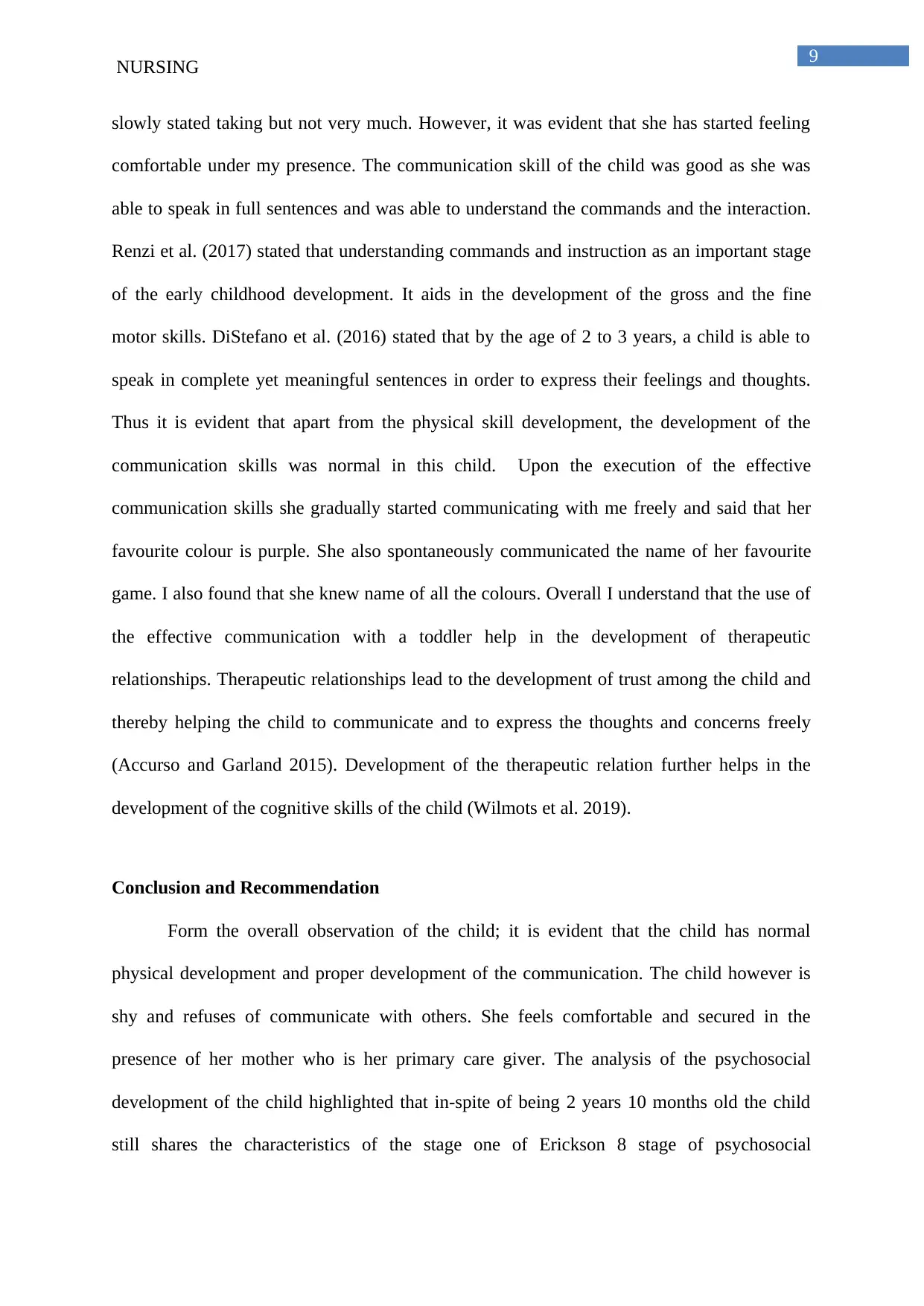
9
NURSING
slowly stated taking but not very much. However, it was evident that she has started feeling
comfortable under my presence. The communication skill of the child was good as she was
able to speak in full sentences and was able to understand the commands and the interaction.
Renzi et al. (2017) stated that understanding commands and instruction as an important stage
of the early childhood development. It aids in the development of the gross and the fine
motor skills. DiStefano et al. (2016) stated that by the age of 2 to 3 years, a child is able to
speak in complete yet meaningful sentences in order to express their feelings and thoughts.
Thus it is evident that apart from the physical skill development, the development of the
communication skills was normal in this child. Upon the execution of the effective
communication skills she gradually started communicating with me freely and said that her
favourite colour is purple. She also spontaneously communicated the name of her favourite
game. I also found that she knew name of all the colours. Overall I understand that the use of
the effective communication with a toddler help in the development of therapeutic
relationships. Therapeutic relationships lead to the development of trust among the child and
thereby helping the child to communicate and to express the thoughts and concerns freely
(Accurso and Garland 2015). Development of the therapeutic relation further helps in the
development of the cognitive skills of the child (Wilmots et al. 2019).
Conclusion and Recommendation
Form the overall observation of the child; it is evident that the child has normal
physical development and proper development of the communication. The child however is
shy and refuses of communicate with others. She feels comfortable and secured in the
presence of her mother who is her primary care giver. The analysis of the psychosocial
development of the child highlighted that in-spite of being 2 years 10 months old the child
still shares the characteristics of the stage one of Erickson 8 stage of psychosocial
NURSING
slowly stated taking but not very much. However, it was evident that she has started feeling
comfortable under my presence. The communication skill of the child was good as she was
able to speak in full sentences and was able to understand the commands and the interaction.
Renzi et al. (2017) stated that understanding commands and instruction as an important stage
of the early childhood development. It aids in the development of the gross and the fine
motor skills. DiStefano et al. (2016) stated that by the age of 2 to 3 years, a child is able to
speak in complete yet meaningful sentences in order to express their feelings and thoughts.
Thus it is evident that apart from the physical skill development, the development of the
communication skills was normal in this child. Upon the execution of the effective
communication skills she gradually started communicating with me freely and said that her
favourite colour is purple. She also spontaneously communicated the name of her favourite
game. I also found that she knew name of all the colours. Overall I understand that the use of
the effective communication with a toddler help in the development of therapeutic
relationships. Therapeutic relationships lead to the development of trust among the child and
thereby helping the child to communicate and to express the thoughts and concerns freely
(Accurso and Garland 2015). Development of the therapeutic relation further helps in the
development of the cognitive skills of the child (Wilmots et al. 2019).
Conclusion and Recommendation
Form the overall observation of the child; it is evident that the child has normal
physical development and proper development of the communication. The child however is
shy and refuses of communicate with others. She feels comfortable and secured in the
presence of her mother who is her primary care giver. The analysis of the psychosocial
development of the child highlighted that in-spite of being 2 years 10 months old the child
still shares the characteristics of the stage one of Erickson 8 stage of psychosocial
Secure Best Marks with AI Grader
Need help grading? Try our AI Grader for instant feedback on your assignments.

10
NURSING
development. This stage is supposed to last for 2 years of life. Thus the main problem with
the child that is being extracted from observational analysis and from The Early Years
Learning Framework for Australia is the child lack self confidence that is important in order
to interact or to make friends with new person. Thus in order to increase the level of self
confidence of the child, it is important to promote a strong sense of connectedness with
others. A childhood educator can do this by ensuring that the children experiences proper
level of pride and required confidence by acknowledging their level of performance and
skills. The acknowledgement helps in improving the level of self-confidence among the child
and thus helping the child to initiate conversation with unknown child or person. Sharing
child success to the families, communities and cultures will help in improving child’s
confidence and helping to grow attachments with others.
NURSING
development. This stage is supposed to last for 2 years of life. Thus the main problem with
the child that is being extracted from observational analysis and from The Early Years
Learning Framework for Australia is the child lack self confidence that is important in order
to interact or to make friends with new person. Thus in order to increase the level of self
confidence of the child, it is important to promote a strong sense of connectedness with
others. A childhood educator can do this by ensuring that the children experiences proper
level of pride and required confidence by acknowledging their level of performance and
skills. The acknowledgement helps in improving the level of self-confidence among the child
and thus helping the child to initiate conversation with unknown child or person. Sharing
child success to the families, communities and cultures will help in improving child’s
confidence and helping to grow attachments with others.

11
NURSING
References
Accurso, E.C. and Garland, A.F., 2015. Child, caregiver, and therapist perspectives on
therapeutic alliance in usual care child psychotherapy. Psychological Assessment, 27(1),
p.347.
Cattuzzo, M.T., dos Santos Henrique, R., Ré, A.H.N., de Oliveira, I.S., Melo, B.M., de Sousa
Moura, M., de Araújo, R.C. and Stodden, D., 2016. Motor competence and health related
physical fitness in youth: A systematic review. Journal of science and medicine in
sport, 19(2), pp.123-129.
Comuk-Balci, N., Bayoglu, B., Tekindal, A., Kerem-Gunel, M. and Anlar, B., 2016.
Screening preschool children for fine motor skills: environmental influence. Journal of
physical therapy science, 28(3), pp.1026-1031.
De Onis, M., 2017. Child growth and development. In Nutrition and Health in a Developing
World (pp. 119-141). Humana Press, Cham.
Deaton, S., 2015. Social Learning Theory in the Age of Social Media: Implications for
Educational Practitioners. Journal of Educational Technology, 12(1), pp.1-6.
DiStefano, C., Shih, W., Kaiser, A., Landa, R. and Kasari, C., 2016. Communication growth
in minimally verbal children with ASD: The importance of interaction. Autism
Research, 9(10), pp.1093-1102.
Fonagy, P., Luyten, P., Allison, E. and Campbell, C., 2018. Reconciling psychoanalytic ideas
with attachment theory. Guilford Press.
Hargie, O., 2018. Skill in theory: Communication as skilled performance. In The handbook of
communication skills (pp. 9-40). Routledge.
NURSING
References
Accurso, E.C. and Garland, A.F., 2015. Child, caregiver, and therapist perspectives on
therapeutic alliance in usual care child psychotherapy. Psychological Assessment, 27(1),
p.347.
Cattuzzo, M.T., dos Santos Henrique, R., Ré, A.H.N., de Oliveira, I.S., Melo, B.M., de Sousa
Moura, M., de Araújo, R.C. and Stodden, D., 2016. Motor competence and health related
physical fitness in youth: A systematic review. Journal of science and medicine in
sport, 19(2), pp.123-129.
Comuk-Balci, N., Bayoglu, B., Tekindal, A., Kerem-Gunel, M. and Anlar, B., 2016.
Screening preschool children for fine motor skills: environmental influence. Journal of
physical therapy science, 28(3), pp.1026-1031.
De Onis, M., 2017. Child growth and development. In Nutrition and Health in a Developing
World (pp. 119-141). Humana Press, Cham.
Deaton, S., 2015. Social Learning Theory in the Age of Social Media: Implications for
Educational Practitioners. Journal of Educational Technology, 12(1), pp.1-6.
DiStefano, C., Shih, W., Kaiser, A., Landa, R. and Kasari, C., 2016. Communication growth
in minimally verbal children with ASD: The importance of interaction. Autism
Research, 9(10), pp.1093-1102.
Fonagy, P., Luyten, P., Allison, E. and Campbell, C., 2018. Reconciling psychoanalytic ideas
with attachment theory. Guilford Press.
Hargie, O., 2018. Skill in theory: Communication as skilled performance. In The handbook of
communication skills (pp. 9-40). Routledge.
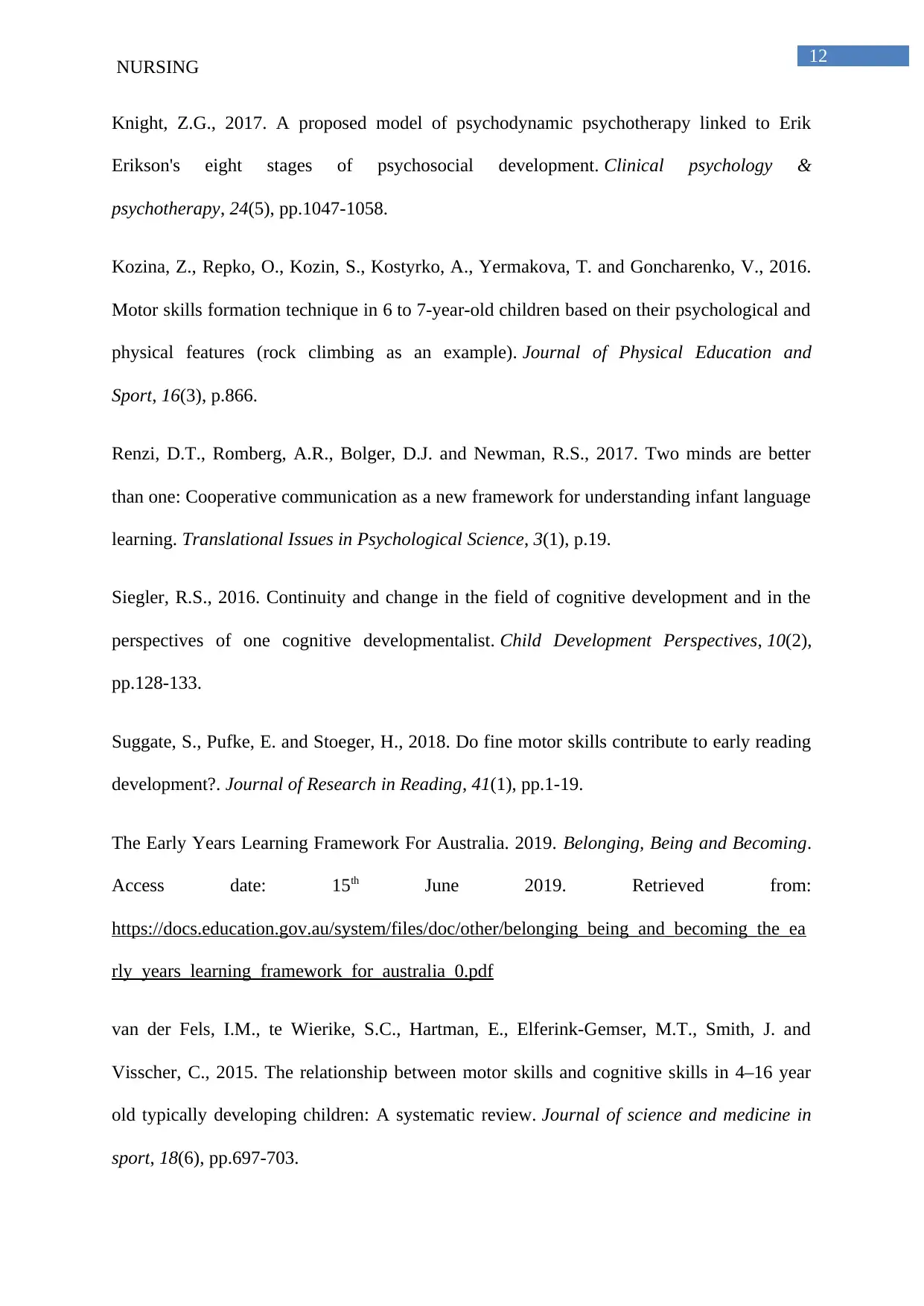
12
NURSING
Knight, Z.G., 2017. A proposed model of psychodynamic psychotherapy linked to Erik
Erikson's eight stages of psychosocial development. Clinical psychology &
psychotherapy, 24(5), pp.1047-1058.
Kozina, Z., Repko, O., Kozin, S., Kostyrko, A., Yermakova, T. and Goncharenko, V., 2016.
Motor skills formation technique in 6 to 7-year-old children based on their psychological and
physical features (rock climbing as an example). Journal of Physical Education and
Sport, 16(3), p.866.
Renzi, D.T., Romberg, A.R., Bolger, D.J. and Newman, R.S., 2017. Two minds are better
than one: Cooperative communication as a new framework for understanding infant language
learning. Translational Issues in Psychological Science, 3(1), p.19.
Siegler, R.S., 2016. Continuity and change in the field of cognitive development and in the
perspectives of one cognitive developmentalist. Child Development Perspectives, 10(2),
pp.128-133.
Suggate, S., Pufke, E. and Stoeger, H., 2018. Do fine motor skills contribute to early reading
development?. Journal of Research in Reading, 41(1), pp.1-19.
The Early Years Learning Framework For Australia. 2019. Belonging, Being and Becoming.
Access date: 15th June 2019. Retrieved from:
https://docs.education.gov.au/system/files/doc/other/belonging_being_and_becoming_the_ea
rly_years_learning_framework_for_australia_0.pdf
van der Fels, I.M., te Wierike, S.C., Hartman, E., Elferink-Gemser, M.T., Smith, J. and
Visscher, C., 2015. The relationship between motor skills and cognitive skills in 4–16 year
old typically developing children: A systematic review. Journal of science and medicine in
sport, 18(6), pp.697-703.
NURSING
Knight, Z.G., 2017. A proposed model of psychodynamic psychotherapy linked to Erik
Erikson's eight stages of psychosocial development. Clinical psychology &
psychotherapy, 24(5), pp.1047-1058.
Kozina, Z., Repko, O., Kozin, S., Kostyrko, A., Yermakova, T. and Goncharenko, V., 2016.
Motor skills formation technique in 6 to 7-year-old children based on their psychological and
physical features (rock climbing as an example). Journal of Physical Education and
Sport, 16(3), p.866.
Renzi, D.T., Romberg, A.R., Bolger, D.J. and Newman, R.S., 2017. Two minds are better
than one: Cooperative communication as a new framework for understanding infant language
learning. Translational Issues in Psychological Science, 3(1), p.19.
Siegler, R.S., 2016. Continuity and change in the field of cognitive development and in the
perspectives of one cognitive developmentalist. Child Development Perspectives, 10(2),
pp.128-133.
Suggate, S., Pufke, E. and Stoeger, H., 2018. Do fine motor skills contribute to early reading
development?. Journal of Research in Reading, 41(1), pp.1-19.
The Early Years Learning Framework For Australia. 2019. Belonging, Being and Becoming.
Access date: 15th June 2019. Retrieved from:
https://docs.education.gov.au/system/files/doc/other/belonging_being_and_becoming_the_ea
rly_years_learning_framework_for_australia_0.pdf
van der Fels, I.M., te Wierike, S.C., Hartman, E., Elferink-Gemser, M.T., Smith, J. and
Visscher, C., 2015. The relationship between motor skills and cognitive skills in 4–16 year
old typically developing children: A systematic review. Journal of science and medicine in
sport, 18(6), pp.697-703.
Paraphrase This Document
Need a fresh take? Get an instant paraphrase of this document with our AI Paraphraser

13
NURSING
Villar, F. and Pratt, M.W., 2015. Psychosocial Development. The Encyclopedia of Adulthood
and Aging, pp.1-5.
Wilmots, E., Midgley, N., Thackeray, L., Reynolds, S. and Loades, M., 2019. The therapeutic
relationship in Cognitive Behaviour Therapy with depressed adolescents: A qualitative study
of good‐outcome cases. Psychology and Psychotherapy: Theory, Research and Practice.
World Health Organisation. 2019. Early child development. Access date: 15th June 2019.
Retrieved from: https://www.who.int/topics/early-child-development/en/
Zhang, L.F., 2015. Erikson’s theory of psychosocial development. International
Encyclopedia of the Social & Behavioral Sciences (2nd ed.).
NURSING
Villar, F. and Pratt, M.W., 2015. Psychosocial Development. The Encyclopedia of Adulthood
and Aging, pp.1-5.
Wilmots, E., Midgley, N., Thackeray, L., Reynolds, S. and Loades, M., 2019. The therapeutic
relationship in Cognitive Behaviour Therapy with depressed adolescents: A qualitative study
of good‐outcome cases. Psychology and Psychotherapy: Theory, Research and Practice.
World Health Organisation. 2019. Early child development. Access date: 15th June 2019.
Retrieved from: https://www.who.int/topics/early-child-development/en/
Zhang, L.F., 2015. Erikson’s theory of psychosocial development. International
Encyclopedia of the Social & Behavioral Sciences (2nd ed.).
1 out of 14
Related Documents
Your All-in-One AI-Powered Toolkit for Academic Success.
+13062052269
info@desklib.com
Available 24*7 on WhatsApp / Email
![[object Object]](/_next/static/media/star-bottom.7253800d.svg)
Unlock your academic potential
© 2024 | Zucol Services PVT LTD | All rights reserved.





